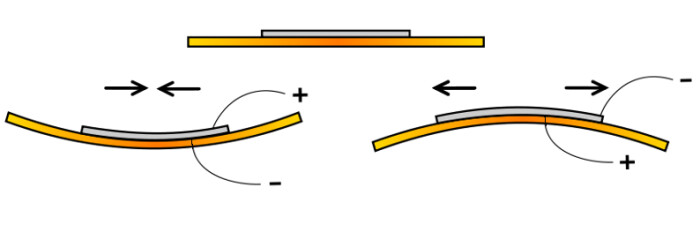Another family of transducers, often put down by audiophiles, is that making use of the piezoelectric phenomenon. Sturdy and not particularly expensive, these transducers have found a place in many speakers with more or less success.
History

History says piezoelectricity was discovered by Pierre and Jacques Curie back in 1880. They were the first to realize that certain crystals polarize when applied a given mechanical pressure and, inversely, deform when an electrical signal passes through them – a new way to transform electrical energy into mechanical energy. The first applications of this didn’t have anything to do with audio, but rather with measuring instruments. It wasn’t until the 1950s and the invention of higher quality piezoelectric ceramics that the first tweeters using this technology started to become more popular (especially thanks to Motorola).
Operation

Each pole of the amp’s output is connected to one of the two sides of the (usually round) piezoelectric ceramic. The ceramic strains proportionally to the voltage of the signal applied to it. When the ceramic is strained, the diaphragm, which is fixed onto the ceramic, bends transforming the electrical signal into a sound wave. Given the weakness of this movement, it is hard to rival the maximum levels provided by electrodynamic speakers. To compensate for the lack of pressure, piezoelectric speakers are often integrated into a horn loudspeaker.
Characteristics
Looking at the impedance curve it’s easy to realize that the piezo transducer has a hard time with the low mids. The impedance of this type of transducer is inversely proportional to the frequency (the lower the frequency, the higher the impedance): it’s meant to operate on the high end of the spectrum (usually above 2 kHz), that’s why they are also called buzzers. While their response in the low end is pretty bad, they are widely used for ultrasonic applications (a sonar, for instance). But there is research going on all the time, especially to increase the amplitude of movement and the frequency range.
The development of its components and low price have favored their integration into multiple sound reproduction systems (home audio and PA systems, instrument amps…), but their inferior performance compared to electrodynamics speakers limit their use among audio enthusiasts. Furthermore, their extensive use in the low end market hasn’t contributed much to the reputation of piezoelectric loudspeakers.

They are functional and respond to lots of needs, but their limited frequency response in the low end and their proneness to distortion restrict their use as studio monitors, except for some very rare exceptions. Their low production cost, sturdiness and dimensions have made them very successful whenever there’s no need for a perfect response across the entire audible spectrum (think of beepers in watches and similar devices with built-in speakers).
In the next and last article we’ll discuss the somewhat particular family of ionic loudspeakers.


